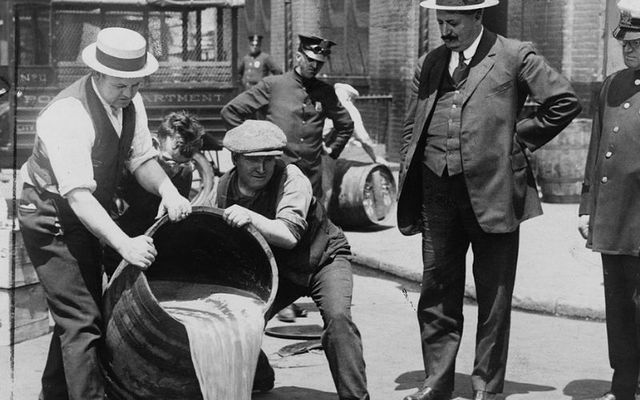On January 16, 1919, the law enforcing Prohibition in the US was ratified. The 18th Amendment to the US Constitution prohibited the “manufacture, sale, or transportation of intoxicating liquors for beverage purposes.”
Here, Tom Deignan looks at Michael A. Lerner's book "Dry Manhattan: Prohibition in New York City."
Back in the early 2000s President George W. Bush was at the time repeatedly accused of exploiting 9/11 and the ensuing Iraq War. Critics charged that the Bush administration had labeled critics of their Iraq policies as disloyal and un-American.
Of course, this is not the first time such a state of affairs has existed in the United States.
In fact, as a book about Manhattan during the early 20th century indicates, World War I saw similar divisions created. Back then, Irish immigrants and Irish Americans played a key role in the direction of US domestic and international policy.
These events also gave rise to Irish mobsters, not to mention gangsters from many other ethnic backgrounds.
Michael A. Lerner's book "Dry Manhattan: Prohibition in New York City" (Harvard University Press) revisits the so-called "noble experiment" of prohibition when alcohol was outlawed in 1920 the way narcotics are today.
Obviously, given rampant stereotypes about the Irish and drink, it may seem unfortunate that Irish America is linked to this topic. But as Lerner notes, this issue was about a whole lot more than booze.
When you look at who was for and against prohibition, it is clear that the Irish were on one side while more respectable, middle-class, and heavily Protestant groups were on the other side.
The two sides came to be known as "wets" (against prohibition) and "dries."
More broadly, prohibition became one battle in a much larger culture war which included attacks against Irish-dominated Tammany Hall, as well as Irish American skepticism about America's 1917 entrance into World War I.
Inevitably, some of Irish America's most famous politicians entered the fray. Typically, because Irish American Democrats were such a large part of their constituency, Irish politicians spoke out against the "dries."
"New York ultimately produced many of the nation's most outspoken wet political leaders, including James J. Walker, the city's "nightclub mayor," Lerner writes about the famously dashing Irish mayor. Lerner adds that "Governor Al Smith's bid for the presidency offered the first real hope for an end to Prohibition."
Smith, of course, rose from Lower East Side poverty to become the first Irish Catholic to run for president, in 1928. He was the target of an anti-Catholic smear campaign to which the Ku Klux Klan and others contributed.
His opposition to prohibition was taken as a sign by many respectable citizens that "those people" should never be allowed to run the country.
As Lerner notes, the Irish and other ethnic groups dominated Tammany Hall. Central to this political machine's operation was the saloon.
This was not just a place to get drunk, but a meeting place to exchange gossip, swap favors, and meet and greet potential voters. By shutting down the saloon, many Irish Americans felt "dries" were actually targeting the Democratic Party organization in New York City and urban centers all across America.

Love Irish history? Share your favorite stories with other history buffs in the IrishCentral History Facebook group.
"Dries" were also not above using prohibition to question the patriotism of the Irish. As the debate over prohibition heated up, America entered World War I in 1917.
Don't forget, the US allied itself with Ireland's mortal enemy, Britain, in that battle. That was trouble enough. But those allies were fighting the Germans, another large ethnic group in New York at the time.
Many prohibitionists felt that anti-British sentiment felt by Irish and German Americans was "un-American."
Couldn't the same be said about their insistence on keeping the saloon open? After all, why waste barley and other grains making booze when those precious commodities could be used toward the war effort?
In the end, as Lerner and many others have noted, prohibition was a spectacular failure. In fact, it succeeded in doing one thing - fueling organized crime, which distributed booze illegally.
Irish gangsters such as Bugs Moran, Deanie O'Banion, Owney "the Killer" Madden, and Vincent "Mad Dog" Coll used bootlegging to make money and spill blood on the streets of New York, Chicago, and other cities, as they battled for their share of the lucrative illegal booze market.
National prohibition officially ended in 1933, though it should be noted that literally hundreds of villages and towns across the US remain legally "dry."
*Originally published in January 2016. Updated January 2023.




Comments